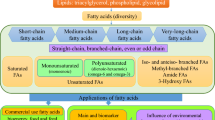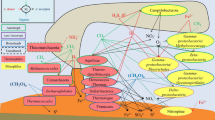Summary
-
1.
Glycogen levels and the production of metabolic end products by the fresh water bivalveAnodonta cygena were determined under aerobic and anaerobic conditions.
-
2.
The glycogen content accounts for 5–14% of the dry weight. After 30 hours of aerobic or anaerobic incubation no significant glycogen breakdown could be observed.
-
3.
L-lactate and alanine seem to be only initial end products, whereas succinate increases continuously during the first 15 hours.
-
4.
Anodonta cygnea also accumulates volatile fatty acids during anaerobiosis. After 30 hours of anoxia 30.1 and 46.0 μmol g−1 dry weight of acetate and propionate respectively are formed. In fact the volatile fatty acids account together for about 75% of the total accumulated end products.
Similar content being viewed by others
References
Badman, D. G., Chin, S. L.: Metabolic responses of the freshwater bivalve,Pleurobema coccineum (Conrad), to anaerobic conditions. Comp. Biochem. Physiol.44B, 27–32 (1973)
Bass, A., Chari, N., Hajek, I.: Comparative aspects of enzyme activity patterns of energy-supplying metabolism in heart muscles of invertebrates and vertebrates. Physiol. bobemoslov.21, 19–31 (1972)
Brand, T. von, McMahon, P., Nolan, M. O.: Observations on the postanaerobic metabolism of some fresh-water snails. Phys. Zool.28, 35–40 (1955)
Brand, T. von. Biochemistry of parasites. New York: Academic Press 1966
Bueding, E.: Comparative aspects of carbohydrate metabolism. Fed. Proc.21, 1039–1046 (1962)
Chen, C., Awapara, J.: Effect of oxygen on the end-products of glycolysis inRangia cuneata. Comp. Biochem. Physiol.31, 395–401 (1969)
Gäde, G.: Octopine dehydrogenase in the fresh water bivalve,Anodonta cygnea. Comp. Biochem. Physiol.48B, 513–517 (1974)
Gäde, G., Zebe, E.: Über den Anaerobiosestoffwechsel von Molluskenmuskeln. J. comp. Physiol.85, 291–301 (1973)
Hammen, C. S.: Metabolism of the oysterCrassostrea virginica. Amer. Zoologist9, 309–318 (1969)
Handel, E. van: Estimation of glycogen in small amounts of tissue. Analyt. Biochem.11, 256–265 (1965)
Hohorst, H. J.: L-(+)-lactat. Bestimmung mit Lactat-Dehydrogenase und NAD. In: Methoden der enzymatischen Analyse (H. U. Bergmeyer, ed.), p. 1425–1429. Weinheim: Verlag Chemie 1970
Karpiak, S. E., Iwanowski, H., Siemieniewski, H.: The content of lactate and pyruvate and the activity of lactic dehydrogenase in adductor muscles of the fresh water mussel (Unio spec.). Arch. Immunol. Therap. Expl.10, 395–404 (1962)
Kluytmans, J. H., Veenhof, P. R., Zwaan, A. de: Anaerobic production of volatile fatty acids in the sea musselMytilus edulis L. J. comp. Physiol.104, 71–78 (1975)
Kmetec, E.: Spectrophotometric method for the enzymatic microdetermination of succinic acid. Analyt. Biochem.16, 474–480 (1966)
Livingstone, D. R., Bayne, B. L.: Pyruvate kinase from the mantle tissue ofMytilus edulis L. Comp. Biochem. Physiol.48B, 481–497 (1974)
Mehlmann, B., Brand, T. von: Further studies on the anaerobic metabolism of some fresh water snails. Biol. Bull.100, 199–205 (1951)
Mustafa, T., Hochachka, P. W.: Enzymes in facultative anaerobiosis of molluses. III Phosphoenolpyruvate carboxykinase and its role in aerobic-anaerobic transition. Comp. Biochem. Physiol.45B, 657–667 (1973)
Read, C. P.: Intermediary metabolism of flatworms. In: Chemical zoology, vol. II. (M. Florkin, B. T. Scheer, eds.), p. 328–389. New York-London: Acad. Press 1968
Saz, H. J.: Comparative energy metabolism of some parasitic helminths. J. Parasit.56, 634–642 (1970)
Saz, H. J.: Facultative anaerobiosis in the invertebrates: pathway and control systems. Amer. Zoologist11, 125–135 (1971)
Schöttler, U.: Untersuchungen zum anaeroben Kohlenhydratabbau inTubifex tubifex. Thesis, University of Münster, W. Germany (1974)
Stokes, T., Awapara, J.: Alanine and succinate as end-products of glucose degradation in the clamRangia cuneata. Comp. Biochem. Physiol.25, 883–892 (1968)
Wernstedt, C.: Metabolism of gill epithelium of a fresh water mussel. Nature (Lond.)154, 463 (1944)
Williamson, D. H.: L-alanine. Bestimmung mit Alanin-Dehydrogenase. In: Methoden der enzymatischen Analyse, II. (H. U. Bergmeyer, ed.), p. 1634–1635. Weinheim: Verlag Chemie 1970.
Zebe, E.:In vivo-Untersuchungen über den Glucose-Abbau beiArenicola marina (Annelida, Polychaeta). J. comp. Physiol.101, 133–147 (1975)
Zs.-Nagy, I.: Adenosine phosphate concentrations and carbohydrate consumption in the tissues ofAnodonta cygnea L. (Mollusca, Pelecypoda) under normal and anoxic conditions. Acta biochim. biophys. Acad., Sci. hung.8, 143–151 (1973)
Zwaan, A. de, Bont, A. M. T. de: Phosphoenolpyruvate carboxykinase from adductor muscle tissue of the sea musselMytilus edulis L. J. comp. Physiol.96, 85–94 (1975)
Zwaan, A. de, Holwerda, D. A.: The effect of phosphoenolypruvate, fructose-1,6-diphosphate and pH on allosteric pyruvate kinase in muscle tissue of the bivalveMytilus edulis L. Biochim. biophys. Acta (Amst.)276, 430–433 (1973)
Zwaan, A. de, Marrewijk, W. J. A. van: Anaerobic glucose degradation in the sea musselMytilus edulis L. Comp. Biochem. Physiol.44B, 429–439 (1973)
Zwaan, A. de, Marrewijk, W. J. A. van, Holwerda, D. A.: Anaerobic carbohydrate metabolism in the sea musselMytilus edulis L. Neth. J. Zool.23, 225–228 (1973)
Zwaan, A. de, Wijsman, T. C. M.: Anaerobic metabolism in Bivalvia (Mollusca). I. Characteristics of anaerobic metabolism. Comp. Biochem. Physiol. in press
Zwaan, A. de, Zandee, D. I.: Body distribution and seasonal changes in the glycogen content of the common sea musselMytilus edulis L. Comp. Biochem. Physiol.43A, 53–58 (1972a)
Zwaan, A. de, Zandee, D. I.: The utilization of glycogen and accumulation of some intermediates during anaerobiosis inMytilus edulis L. Comp. Biochem. Physiol.43B, 47–54 (1972b)
Author information
Authors and Affiliations
Additional information
This work was supported by “Deutsche Forschungsgemeinschaft” (Ze 40/13).
Rights and permissions
About this article
Cite this article
Gäde, G., Wilps, H., Kluytmans, J.H.F.M. et al. Glycogen degradation and end products of anaerobic metabolism in the fresh water bivalveAnodonta cygnea . J Comp Physiol B 104, 79–85 (1975). https://doi.org/10.1007/BF02482839
Received:
Issue Date:
DOI: https://doi.org/10.1007/BF02482839




